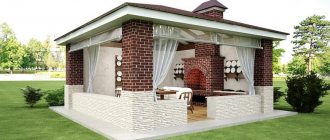Finishing
When installing plastic windows, old wooden window sills are dismantled and replaced with new structures. Standard white surfaces do not suit all users. Recently, cladding with original mosaics and ceramic tiles has become popular.
Classic option for finishing a large surface
Peculiarities
A properly installed window sill will decorate any room. Finishing with universal tiles is a rational solution. This material is not afraid of moisture, resistant to dirt and stress. High-quality cladding increases the strength of the structure. Tile surpasses even plastic in all respects, as it does not fade, is not afraid of contamination, and is easy to clean.
An original option for the kitchen
Examples
You can appreciate the aesthetics of a tiled window sill by looking at the examples in the photo gallery.
- A neat window sill, decorated with small mosaics in classic colors: brown and beige.
- Window sill trim with square brown tiles.
- Glossy tiles for a wide window sill in pastel colors. A practical and stylish option.
- A contrasting combination of light and green mosaic tiles will decorate the window sill and refresh the interior of the room.
- A practical window sill decorated with glossy tiles. The structure can be used as an additional workspace.
See the next video for more details.
DIY repair
You can finish the window sill yourself. Some tips:
- It is necessary to check the integrity of the base: there should be no cracks, large scratches, chips, voids or other defects on the surface.
- The best base for tiles is concrete. This finishing material fits well even on wood and plastic.
- The working surface must be well secured in the opening.
- Finishing should begin after installing the window frame and external sill.
Cutting tiles
Granite window sills - a few secrets of stone beauty
Required Tools
Window sills made of granite, porcelain stoneware and marble will last for many decades - both as an elegant completion of the renovation, and in terms of the convenience of placing various home interior items on them. Selecting and installing such window sills will require certain skills and “tricks”!
Granite window sills - pros and cons
Window sills made of natural or artificial stone are used relatively rarely as the final finishing of window openings. But in vain! After all, such material not only has a solid mass (which objectively complicates installation), but also significant operational advantages:
- Durability. In principle, the prefix “long-” can be discarded altogether. A correctly selected and high-quality granite window sill will survive any repair and will require replacement only for aesthetic reasons . For example, during a new major renovation and replacement of some window frames with others;
- Fundamental thoroughness. On a stone shelf under the window you can place heavy and bulky interior items - from massive flower pots to in-folio books. In terms of load-carrying capacity, no other type of window sill can be compared with stone ones, be it the usual wood or light plastic;
- Design advantages. Various options for the final finishing of walls and window slopes, flowing curtains and tulle curls are in good harmony with the appearance of stone, porcelain stoneware or marble;
- Repair reliability. Stone has been synonymous with the quality of a home since ancient times; it is quite acceptable to use it partially in renovations, making it a noticeable detail of the entire interior of the room.
Ease of maintenance. Natural and artificial stone are resistant to moisture, bad weather, household chemicals and mechanical shocks. It is enough to periodically wet clean a durable and perfectly flat surface so that such a window sill always looks like new;
Of course, purchasing and installing stone window sills has its own characteristics. They are associated with the large weight of marble/granite, which means high demands on the quality of installation. In addition, there are nuances when choosing the material itself.
Choosing window sills sparingly
The stereotypes of our consciousness attribute a high cost to marble (which is, in principle, true) and extend this opinion to granite and porcelain stoneware (which is not always true).
If made from granite or porcelain stoneware, the window sill can be even cheaper than a wooden one. Under the indispensable condition that it will be a composite product.
Let's explain in more detail. You can also order a solid window sill made of natural or artificial stone, several meters long to fit the dimensions of the window, and 30-50 cm wide. But such an order will probably cost more than all the PVC windows in the room, or even in the entire apartment. In addition, its weight will be so significant that it will require calling a special team of loaders and installers. Which will affect the size of the repair estimate in the most deplorable way.
The solution is to install a composite window sill. Now there are many companies on the market working with stone. And they always have production leftovers of granite, porcelain stoneware and even marble, which can be purchased at the lowest residual value. Moreover, the color and texture of the pieces will be quite identical, they will be processed, polished, etc. accordingly.
Naturally, a preliminary search for such stone “panels” will require time and effort, and you will need to travel to hardware stores and markets. But thanks to composite stone parts, you can save up to 50% of the price of a solid window sill; you can combine individual parts and perform the installation yourself. It is important to understand that with an active and successful search for material, almost everyone can afford a granite window sill. It will cost only several times more than a plastic window sill - and we have already described the advantages of stone over plastic.
Window sills made of porcelain stoneware and granite - installation features
The typical sequence for installing a composite stone window sill is as follows:
- Make sure that the window frame is installed accurately and check the ease of movement of the opening parts (transoms, sashes, etc.). It is along the bottom line of the frame frame that the window sill will be aligned, and it is much heavier than the window. So the window must be installed with a large margin of safety;
- The concrete base on which our porcelain stoneware window sill will be installed must be level and free of any debris. Ideally, it should be pre-filled with fresh solution, then the entire installation is easier and faster, fitting the parts to each other takes a minimum of effort, etc.;
- Using polyurethane foam, the gaps between the frame and the window opening are processed (except for the bottom, where the installation will be carried out). Work on preparing the walls for installation of slopes should also be completed at this stage;
- It is necessary to cut the mounting openings for installing the window sill in the side walls by 5-8 cm. Due to the heaviness of the entire structure, it should be fixed not only with mortar and glue from below, but also supported on the side masonry of the walls;
- It is advisable to limit the total number of parts to three or four, otherwise it is difficult to maintain an ideal installation line. It is highly advisable to cut the parts of our window sill to the same size in length and thickness, then their joining seams will look natural and harmonious. The variation in width is permissible within a few centimeters; they can be “hidden” under the window, in the installation opening;
- Installation begins from any of the convenient sides. Having pushed the granite slab into the side opening and under the window until it stops, then “pull” it towards you and to the side by 1.-2 cm, for freedom of installation. Then, using an accurate level, the slab is perfectly horizontal;
- The quality of the entire window sill depends on the accuracy of installation of the first part. It is necessary to stock up on wooden wedges to secure the slab; a clamp (one or more) is often useful. After leveling, you need to pour the solution or glue from the bottom and sides and wait for it to harden;
- Others are connected to the installed part of the window sill in a similar way. With the exception that after selecting strict horizontality, the ends of the plates are coated with glue and pressed tightly against each other. Excess glue squeezed out of the seams is carefully removed with a sharp knife or razor. The top of the seam is wiped with acetone or another suitable solvent to give it the necessary gloss and eliminate glue residues.
After assembling the entire composite window sill, the joints of the individual slabs can be sanded using a drill with sandpaper attachments - then the complete illusion of a solid slab will appear under your new window. This operation is performed carefully, using fine sandpaper - otherwise, instead of sanding, you will get concentric scratches and unevenness. It is imperative to use safety glasses; even a miniature piece of stone can seriously damage your eyes.
What is necessary
To lay ceramics efficiently, you need to prepare the necessary tools and consumables. The standard list includes:
- Universal primer.
- Adhesive solution.
- Tile.
- Grout for seams.
- Pliers.
- Glass cutter.
- Hacksaw.
- Building level.
- Small rubber mallet.
- Standard spatula.
For the window sill in the kitchen, porcelain stoneware is the best choice. This material has high strength.
Basic set of tools
Porcelain stoneware is durable and high-density. The finished structure perfectly resists the influence of adverse factors. You can place hot dishes and heavy objects on porcelain stoneware.
Required Tools
A universal list of tools that will be required during the work process:
- Universal type soil mixture.
- Adhesive solution.
- Tile.
- Marker for marking.
- Rubbing material for seams.
- Pliers.
- Glass cutting tool.
- Hacksaw.
- Level.
- Hammer (it is better to choose a rubber one so as not to damage the materials).
- Spatula (regular one is enough).
In order not to waste a lot of time, such materials for work can be found in the same store where you will buy the tiles.
Subtleties of preparing the base
Each time cladding work should begin with this procedure. Carefully remove old enamel, putty, and other coating. You also need to remove all dust and dirt. After this, a deep penetration primer is applied to the surface. Increased attention is paid to the selection of high-quality ceramics.
If the window sill is compact, then the finishing material should be small. Elements measuring 10x10 or 15x15 cm are quite sufficient.
For large window sills it is better to choose larger tiles. In some cases, the choice can be made on elements measuring 40x20 or 30x30 cm.
It is not difficult to choose high-quality finishing ceramics. This material is available in a wide range.
Scope of application
Most often, a tile window sill is made in houses made of brick, ceramic concrete, foam concrete or cinder blocks. In these houses, the window sill, as a rule, has already been filled or a kind of blank has been made that will serve as its base. It must be thoroughly cleaned of dust and primed to increase the adhesion of the material to the base. If this is not done, the tiles may fly off within a few months.
If there is already a window sill, but you need to make a new cladding, you must first remove the old one. Next, the surface of the window sill is carefully leveled, all dents and chips are filled with putty. In order for the tiles to last for many years, you need to purchase putty, primer and glue from one manufacturer in stores.
Masonry technology
There are two options: along the entire window and perpendicularly. The choice should be based on minimizing the resulting trimming of parts. To adjust the die, you can use a classic glass cutter.
The location of the cut should be marked in advance using a marker. The trim is placed on a flat and stable base in order to trim along the marked points. During the procedure you need to press hard on the material.
It is difficult to achieve a high-quality result without a rubber hammer. Using this tool, carefully tap the ceramic product on the back side at the site of the intended cut. If such a hammer is not at hand, then you can use the handle of a spatula, which is first wrapped in a towel or thick cloth.
The required fragment is broken off with a sharp, confident movement. If the master has the necessary skill, then cutting the ceramics can be done with a grinder. This electric tool saves a lot of effort and time.
Rational approach
Ebbs and visors of plastic windows
A plastic window is not only a double-glazed window and a frame, but also a number of additional elements, without which the window as a whole will not have a finished look and will not last for a long time.
For example, owners of PVC windows cannot do without such special devices as ebbs and canopies that will drain melt and rain water. These structures are installed on the outside of the window in its upper and lower parts, so they are invisible to the eyes of the inhabitants of the house. Ebbs and visors are designed not only to drain precipitation, but also to protect the installation seam under the window. If the seam is not closed in time, moisture will damage it, which can lead to the destruction of the wall and the window falling out. Even if you have an expensive PVC window installed without high-quality drainage, it may soon, in just a couple of years, become unusable.
Ebbs and visors can be made of plastic, tin, galvanized steel and aluminum. Today they are practically not made from tin, since it rusts too quickly, and also looks unsightly, spoils the facade of the building and allows water to pass through. Drains made of galvanized steel do not have these disadvantages, which is why they are now the most popular among consumers.
The color palette of the composition can be very diverse. In addition, such varnish helps to extend the life of the drainage system, as well as preserve its appearance. The ebb or visor covered with this composition will not fade in the sun and will be resistant to temperature changes. Window structures treated with polymer will give the appearance of the entire house a finished look.
After the all-metal sheet is painted, it is cut into pieces and given the required shape.
As you can see in the photo, the shape and size of the ebb and visor of a plastic window can be very different:
They are often made according to customer drawings.
It should be noted that ebb tides and visors are produced by both domestic and foreign manufacturers.
Those produced abroad will cost more, but this does not mean that they have better quality characteristics compared to domestic ones.
Drainage systems manufactured in Russia have a number of important advantages: low cost (and, consequently, low final price) and durability, which is ensured through the use of high-quality steel.
Compared to castings made of aluminum and plastic, steel structures are superior in a number of indicators:
- resistant to UV radiation;
- look aesthetically pleasing;
- resistant to precipitation (rain, snow) and temperature changes;
- resistant to corrosion;
- durable;
- resistant to mechanical damage;
- are inexpensive.
It should be noted that plastic moldings can also be used for installation on the outside of windows.
In addition, plastic elements are durable, do not require special care, do not fade when exposed to sunlight, and also increase the sound and heat insulation of PVC windows.
Visors and sills are easy to manufacture, but they require some work to install correctly.
This design will allow you to use drainage systems for the maximum amount of time.
The next section of the article is devoted to which slopes are best to choose for plastic windows.
Traditional installation method
Before you begin installing ceramics, you need to prepare high-quality glue. The solution is applied with gentle movements to the back side of the finish and the work surface. You can use a spatula to distribute the composition. During installation, you need to ensure that the elements of the pattern match.
There must be a gap between the dies. To ensure that all the parts lie at the same distance from each other, special plastic crosses are used, which also differ in size.
Experts recommend forming a slight slope of the structure from the window to the outside. Thanks to this, it will be possible to avoid the accumulation of condensation, since all the water will flow from the base of the frame to the very edge. The end parts are mounted only after the laying of the horizontal dies is completed. Once all the tiles have been laid, you can proceed to using putty. It is more practical to use a dark shade. Popular options:
- Blue.
- Beige.
- Brown.
- Burgundy.
The choice of putty shade depends on the color of the tile. Once the solution has completely hardened, the window sill is thoroughly cleaned. After this, the updated surface is completely ready for use.
Attention! During work, you need to ensure that all vertical and horizontal elements are as consistent as possible with each other at the joints.
Interesting shades of grout
Tiles - on the windowsill. What is the most “harmful advice” you have received for your home?
Everyone who started a renovation had to listen to advice from mom, dad, relatives, and friends on how and what to do best.
Not all advice is good. Houzz.ru surveyed its readers—designers and non-designers alike—and they shared stories of “bad advice.” - Lay carpets. Everywhere. And they were very surprised when they didn’t do that.
— Make arches instead of “boring” openings)
— Ceiling installers are actively offering black glossy ceilings.
- Yes, everyone always advises to stretch the ceiling! It's so beautiful! Maybe I don’t understand something, we never use them in projects, and I would never make them for myself...
— I don’t remember much, but from the last one: remove unnecessary sockets, put sockets with a gold rim, wallpaper on the ceiling, suspended ceilings, different floor coverings in a one-room apartment, block the doorway with bricks so that the door is shorter and, accordingly, cheaper, a mirror with engraving.
— Tiles in the bathroom up to the ceiling, because “that’s how it’s done.”
- “Why are you making so many sconces everywhere? Are there not enough chandeliers for you?”
— The table MUST be under the tablecloth. I just have to and that’s it.
— And all sorts of little things like remote controls in cellophane))).
Photo: uznayvse
— I remembered how the foreman strongly recommended a protective frame for sockets. “And so that the areas around the sockets do not get dirty.” Even then we thought that this was even worse than the remote control in the bag).
— They advised to abandon a normal bed with a high-quality mattress in favor of a folding sofa (“but the guests will come, where will they sit?!”)
— Refuse white furniture because it gets dirty.
— They recommended sticking tiles on the ceiling. Seriously, a friend gave me this advice. It’s like that in his kitchen - he says so that the neighbors don’t flood it.
— But for my former customer (IT technology, a vegetarian who constantly goes to some mysterious Ashram of his), his sister advised him to place an iconostasis on the wall in the kitchen from the beginning of the renovation. There is only an island, a bar counter and an empty plasma wall. And once every six months he always writes to me by email - maybe he should? True story, by the way.
— I believe that you can and should listen to a professional, but only in the part in which he is a professional. For example, if a foreman insists on the technology of work, then he is right, but if he interferes in interior decisions, advises “to remove the red stripe,” “hang a shelf over there,” or “cover this little seam with a neat plastic cover,” then such advice will go straight to ballot box...
European-quality renovation. Photo: blackseaplus
— They advised us to make one bathroom in a two-story townhouse with an attic. Like, why do you need three bathrooms? There are two of you. Well, yes, they used to do without water closets at all.
— Lower the ceiling to 3.30 m because it will be difficult to paint later.
- Why are all your walls gray? - the mother-in-law was indignant. — At least make the corridor yellow.
“And my mother, looking at my gray walls, suggested covering all this disgrace with flowered wallpaper (certainly flowery). You see, everyone who gets painted like that (what programs have you seen enough of?) will definitely have it remade, and you’ll get tired of it.
— Leaving the bathroom, the guest suggested putting a peg under the wall-mounted toilet, “otherwise someone might be heavier.” »
— Throw out the antique floor-standing, ceiling-high, 19th-century mirror in a carved wooden frame and buy in its place “a normal wardrobe, like all normal people have.”
— Advice from a realtor is to replace the pre-revolutionary parquet with a new one.
— A month ago I bought my first apartment. Two friends arrived. And it began... “You don’t have curtains on the windows! How so? The first thing you need to do is curtain the windows! Everyone can see everything!” By the way, I have an amazing view from the window - there is a square under the windows, somewhere in the distance there are other houses and even further away - the mountains. Fifth floor. I can't stop looking at it. No! They even brought curtains with them!
- Let's cover your window sill with tiles, it won't be visible anyway, there will be tulle hanging there.
Photo: yardyam
— My family didn’t so much advise me as dissuade me, something like “white walls are like in a hospital”, “it’s colder with painted walls than with wallpaper”, “white doors - they’re ugly”, “flooring without thresholds and it’s the same everywhere - it’s somehow strange,” and much more...
Sheathing base made of wood and plastic
The process of finishing window sills from natural materials is no different from finishing concrete surfaces. But in this case, the craftsman will have to cover the entire structure with plasterboard slabs in order to then lay the colored tiles. You can do without cladding gypsum board, but in such a situation you should use an acrylic primer, which is used to cover wooden window sills. For installation you will need epoxy glue and grout.
It is much easier to decorate plastic bases. Instead of an adhesive solution, you can use liquid nails. The reliability of adhesion directly depends on the texture of the plastic. Specialists use special compounds for laying ceramic products on plastic or wooden bases.
Why do tiles fall off?
Tiles can fall off for two reasons.
The first is that you are using tile adhesive that is too liquid; it absorbs and dries quickly, causing adhesion to deteriorate and adhesion to decrease. In modern adhesive tile mortars this is unlikely, since they contain various additives and fibers that prevent this.
The second reason for tiles falling off most often is that the master does not apply a contact layer to the base of the window sill or does not apply tile adhesive to the tile itself - in both cases, the quality of adhesion suffers irreversibly and this cannot be done because adhesion is reduced significantly and the tile sooner or later it will fall behind.
If your window sill is made at an angle, the corner tiles must be cut with a tile cutter into a wedge-shaped shape. Since after this its area will decrease, such a tile will be a weak link, so pay especially close attention to laying such a tile and grouting its seams.
The outer tiles of the window sill must be deepened into the wall and window slope as much as possible, so that water does not accumulate at the joints and does not run along the facade, leaving behind streaks.
Original mosaic decoration
This facing material looks unusual. The installation process is more accessible than the option with ceramic tiles, since the procedure for finishing the window sill takes less free time. A correctly selected mosaic decorates the room.
The only drawback of such cladding is that there will be many seams on the surface, which can become the main reason for the rapid growth of mold and mildew. Such areas are difficult to clean from contamination. To avoid this problem, you need to use high-quality grout.
The dimensions of the mosaic can be easily adjusted. Before laying, the work surface is prepared in the same way as with tiles. At the final stage, the base should be thoroughly cleaned of dirt and construction dust.
When laying transparent mosaics, the glue should be white. Insulation of the base is carried out before finishing work.
The video shows an original version of finishing a used window sill with homemade mosaics:
Benefits of cladding
Most contractors who finish window sills with tiles highlight the following advantages:
- Visual. The apartment owner can choose tiles that suit the interior design of the room. The uniqueness of the work depends only on the imagination of the customer.
- Physical characteristics. By decorating the area near the window with ceramics, the apartment owner can avoid frequent cleaning. The tile is not so susceptible to dirt and dust and is easy to clean. In addition, it is able to withstand greater physical stress than conventional plastic.
- Duration of operation. Ceramic tiles benefit significantly when it comes to durability. In addition to the service life, the strength of the entire structure increases several times.
In short, in almost every component, ceramic or tile will be better for the home. If renovations in the house are being done “for yourself,” then it is recommended to opt for higher quality materials.
Advice from experienced masons
The cladding process will not be difficult if you pay attention to the following factors:
- Surface condition. The base must be complete. If during preparation you find cracks, large scratches, chips, empty spaces, etc., then the problem should be corrected. If you ignore these nuances, the finish will not be of high quality. The tile can simply crack.
- Choosing a base. A concrete base will ensure the durability of the structure and high quality of finishing in general. It will lie on any surface (wooden or plastic) without any problems.
- Surface condition. After checking the area of work, you need to make sure that it is firmly fixed in the opening and will not “ride” during installation.
- Choosing the tile itself. The most important aspect. The type of masonry and the complexity of the work depend on the size of the tile. The diagonal of the tile is selected based on the size of the base. If it is not large, then it is recommended to go with 10x10 or 15x15 tiles. This will eliminate the need for cutting and will give the surface a more attractive appearance. If the dimensions of the base allow you to choose a larger tile, then you can think between 30x30 or 40x20 centimeters. Any store has a wide range of products, so choosing a model is not difficult.
Installation begins only after a new double-glazed window has been installed and the external type of drip has been correctly installed.











